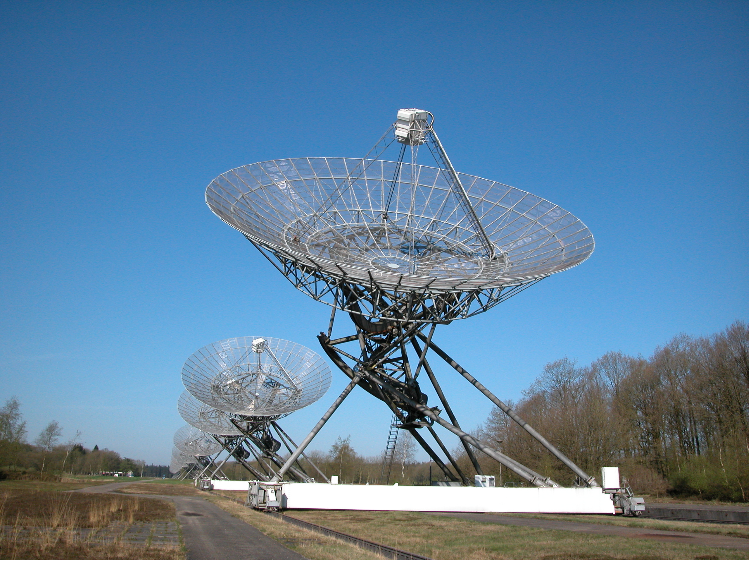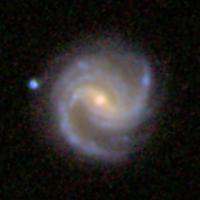 |
|
 |
 |
|
 |
The page gives an overview of the data, and acts as a repository to download data.
The WSRT HI data were reduced using a pipeline from Paolo (see Serra, Oosterloo, Morganti et al. 2012), pipeline adjustment and quality control was done by Gyula and Paolo. For questions contact Paolo and Gyula.
The data cubes that can be downloaded here are the result of a data reduction using 5 different combinations of Robust weighting (Robust 0, Robust 0.4, Robust 6, indicated by "Rob" in the table) and tapering (no tapering, 0, 30 arcsec tapering, "30"). In short, this ensures that we cover some range of spatial resolution and sensitivity in the data cubes. A lower robust parameter and a lower tapering corresponds to a higher resolution at the expense of sensitivity. The resoluton and sensitivity for each tapering and weighting choice can be found here Throughout, the velocity resolution for these data cubes is 24 km/s (FWHM, the width of one channel is 12 km/s). The current data cubes are optimised for a visual inspection. We can change the velocity resolution down to 4 km/s (at the expense of sensitivity in a single channel), cube sizes, and spatial resolution once the scientific necessity arises. Some caution is required here: processing one set of data takes about an hour, hence reprocessing all data takes more than two days.
The data have science quality with the following limitations: the data cubes are reliable within a range of +-400 km/s with respect to the the main source velocity.
We use a source finder to produce a mask that outlines tentative volumes with emission in the data cube. Using that mask, a total-intensity map (moment-0) and a velocity field is calculated. Furthermore, we calculate the source total HI fluxes within tentatively detected volumes.
HI masses were calculated following
\({\rm M_{HI}=2.356*10^5*(D_{lum}/Mpc)^2*(F_{tot}/Jy\ km\ s^{-1})} \), where
\({\rm F_{tot}=\int S_{radio}(V_{radio}) dV_{radio}} \) (radio velocity!),
Sradio: flux density,
\({\rm D_{lum}= cz*(1+z(1-q_0)/2)/H_0 }\) approximation to luminosity distance,
\({\rm q_0=\Omega_M/2-\Omega_{\lambda} }\),
\({\rm \Omega_{\lambda}=}\)0.7 vacuum energy density,
\({\rm \Omega_M=}\)0.3 matter density,
H0 = 70.4 (km s-1)/ Mpc Hubble constant,
c = 2.998*105 km s-1 speed of light.
The correction for the HI mass, changing the ordinary Hubble distance to luminosity distance amounts to ~4% (upwards).
HI total-intensity maps were converted to column-density maps using:
NHI/(atoms cm-2) = (1+z)4*1.249*1024*(Itot/(Jy km/s beam-1))/(\(\Omega\)beam/arcsec2), where
Itot = \(\int\) Iradio(Vradio) dVradio total intensity,
Iradio(Vradio) intensity (radio definition),
\(\Omega\)beam = 1.13309*\(\theta\)maj*\(\theta\)min beam solid angle,
\(\theta\)min minor axis half-power-beam-width (HPBW) (beam: 2d Gaussian point spread function),
\(\theta\)min major axis half-power-beam-width (HPBW) (beam: 2d Gaussian point spread function).
Again, notice that we use the quantities depending on the radio definition for the velocity:
Vradio = c*(\(\nu\)0-\(\nu\))/\(\nu\)0, where
c = 2.998*105 km s-1 speed of light,
\(\nu\)0 = 1.420405752 GHz HI rest frequncy,
\(\nu\): observed frequency
and not the optical one:
Voptical = cz = c*(\(\nu\)0-\(\nu\))/\(\nu\) .
The term (1+z)4 imposes a correction of the order of ~10%.
Notice that all maps and cubes have been converted to carry frequency on the third axis in the wiki, which is the native unit for radio data. Calculations, however, were performed with maps using the radio velocity definition. To switch to a different reference system for the third axis, it is recommended to install miriad (see below, there are binary versions available), to convert the data to miriad format with the task fits, to then convert the third axis with the task velsw, to then convert the data back to fits with the task fits.
Notice that the velocity scale in the optical definition is not linear (since natively the channels are separated by a constant delta in frequency) and that only very specialised visualisation software can deal with that (Karma can). The values of the reference pixel change according to:
\(\nu\)ref = \(\nu\)0*(1-(Vradio,ref+Vobs)/c)
\(\nu\)ref = \(\nu\)0*(1-Voptical,ref/(Voptical,ref+c)+Vobs/c)
Here, Vobs is the velocity of the reference frame (heliocentric, LSR) with respect to the observatory as measured in the radio convention (keyword vobs in the header).
For computational reasons, in Miriad the pixel scale and the clean beam (point spread function) properties vary with frequency. The observatory velocity Vobs (keyword vobs in the header) is always defined in the radio convention and frequency and radio velocity are connected via:
\(\nu\) = \(\nu\)0*(1-(Vradio+Vobs)/c)
Then the pixel scale of the spatial coordinates changes with frequency according to:
\(\Delta x(\nu)\) = \(\Delta x(\nu\)ref)*\(\nu\)ref/\(\nu\)
\(\Delta y(\nu)\) = \(\Delta y(\nu\)ref)*\(\nu\)ref/\(\nu\)
where \(\nu\) is the frequency and \(\nu\)ref the reference frequency (crval3 for frequency definition) for which \(\Delta\)x(\(\nu\)ref) (cdelt1) and \(\Delta\)y(\(\nu\)ref) (cdelt2) are specified in the header.
The same accounts for the Half-Power-Beam-Widths \(\theta\)maj and \(\theta\)min of the point spread function, for which the reference values are given in the header as bmaj for \(\theta\)maj(\(\nu\)ref) and bmin for \(\theta\)min(\(\nu\)ref).
\(\theta\)maj(\(\nu\)) = \(\theta\)maj(\(\nu\)ref)*\(\nu\)ref/\(\nu\)
\(\theta\)min(\(\nu\)) = \(\theta\)min(\(\nu\)ref)*\(\nu\)ref/\(\nu\)
Again, the reference frequency can be calculated via:
\(\nu\)ref = \(\nu\)0*(1-(Vradio,ref+Vobs)/c)
\(\nu\)ref = \(\nu\)0*(1-Voptical,ref/(Voptical,ref+c)+Vobs)/c)
Jing put quite some effort in calculating limits for the HI total-intensity maps. The active group members are aware of the limitations of such a surface brightness confidence limits.
The value of a non-zero pixel P1 in the total intensity map is the sum of voxels at the same sky position from several channels. If we sum up the whole sky region along these channels to make a temporary total intensity map IM1, the r.m.s. of pixel P1 can be approximated as the r.m.s. of map IM1. The r.m.s. of map IM1 is estimated by fitting a gaussian function to the negative pixels. By repeating this process for every non-zero pixel in the total intensity map, we produce a r.m.s map for the total intensity map. The depth of the total intensity map in 1 $\sigma$ is evaluated as N(border)/N(all) percentile of the r.m.s map, where N(border) is the number of pixels along the border of non-zero regions, and N(all) is the total number of non-zero pixels. It is based on the fact that for most galaxies the outer regions have shorter channel coverages than the inner regions. The estimated depth in 4 $\sigma$ has a typical value of 0.7, which is consistent with the typical values that could be estimated from the observation condition, beam size and source finder strategy.
Milan provided Gauss-Hermite fits to the data cubes resulting in velocity fields that are superior to the moment-1 maps. The velocity fields were calculated for two series of data sets.
When downloading data, the file names (which differ from the entries in the tables) are coded such that they identify the data sets:
jrrrrrr_dddddd_rl.m_tnn_suffix.fits(.gz)
denotes a data set from an observation of the main target with
For each weighting scheme, we provide
Please notice that the fits data are not primary-beam corrected.
In short, the data cubes and total-intensity maps presented here are tapered by a function called the primary beam. The standard primary beam correction is to divide the map/cube by this function. The reason for not doing it at this stage is to preserve noise uniformity across the image. As a standard for the WSRT
cos6(k*(\(\nu\)/GHz)*(\(\alpha\)/deg)) is used, where
k = 68 is a constant,
\(\nu\) is the frequency and
\(\alpha\) is the angular distance from the pointing centre (reference pixels of the maps) respectively.
This is fine for smaller fields. However, it is known that this primary beam function is modulated by a 17 MHz periodic pattern (see Popping & Braun 2008), causing deviations from the standard correction of up to more than 10% for large distances (~0.5 degrees) from the field centre. 17 MHz correspond to a velocity range of 3588 km/s (radio), while our HI data cubes span approximately 1900 km/s. This means that using a standard correction for analyses on larger fields will lead to an error of the same order, unless the issue is addressed. Basically, we have to find a primary beam correction that changes over frequency and is applied to each channel in a data cube. There are a two possible strategies:
i) use the empirical model of Popping & Braun 2008 for the primary-beam correction -> problem: getting the model... ii) calculate a primary beam correction for each observation by comparing NVSS to a data cube for which the continuum has not been subtracted. A possibility could be to assume that k in the formula above is a periodic function in frequency, but this has to be investigated further. One obstacle is of course how exactly the intrinsic spectra of reference sources is known. Investigations start soon.
Source catalogues as extracted by the HI source finder are added in the tables. The ascii files contain in this order:
The active people are currently mostly looking at the Robust 0.0/taper 30 arcsec and Robust 0.4/untapered data.
We recommend the following software to visualise and manipulate the data:
Karma HI visualisation tool suite
http://www.atnf.csiro.au/computing/software/karma/
Analysis:
Miriad (mainly data reduction package, but some analysis tools)
http://bima.astro.umd.edu/miriad/
GIPSY analysis package
http://www.astro.rug.nl/~gipsy/
tirific tilted-ring fitting
http://www.astron.nl/~jozsa/tirific/
...and of course more (pyfits, ds9, add here ...)